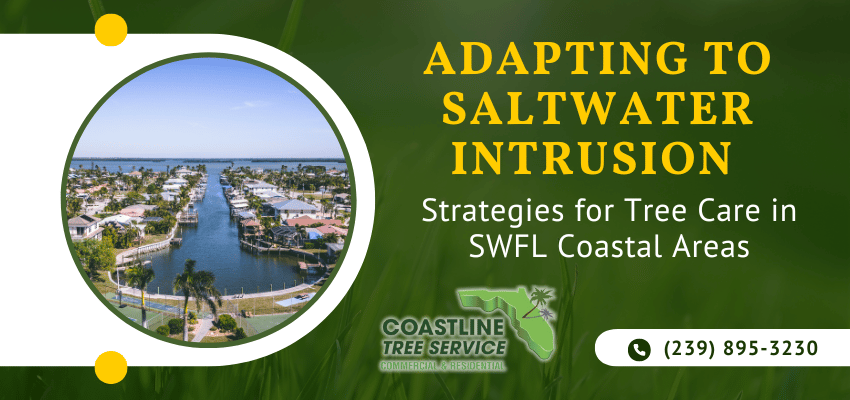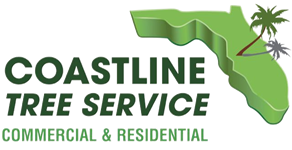
Adapting to Saltwater Intrusion: Strategies for Tree Care in Coastal Areas
In the wake of Hurricane Milton, residents of coastal Southwest Florida face intensified challenges in maintaining their landscapes. This recent hurricane not only brought fierce winds and torrential rain but also exacerbated saltwater intrusion by carrying salt-laden air and precipitation inland. The increased soil salinity resulting from these conditions poses a significant threat to the health of trees and plants in the area. At Coastline Tree Service, we recognize the urgency of addressing these challenges and are committed to helping you adapt and protect your garden oasis in these demanding conditions.
The Impact of Saltwater Intrusion on Tree Health
Saltwater intrusion occurs when seawater encroaches into freshwater systems, increasing soil salinity. This can lead to osmotic stress, nutrient imbalances, and toxicity in plants, causing leaf burn, stunted growth, and even death if left unmanaged. Understanding these impacts is crucial to maintaining healthy trees in coastal Southwest Florida, where salinity levels can vary significantly. Here are essential strategies to effectively combat saltwater intrusion, ensuring your coastal landscape remains healthy and vibrant despite the challenges posed by saline conditions.
Expanded Strategies for Selecting and Caring for Salt-Tolerant Tree Species
-
Choosing Native Species: Opt for salt-tolerant native species like Southern Live Oak, Red Cedar, and Sabal Palm, which are naturally adapted to saline conditions. These trees are more likely to thrive compared to non-native species.
-
Proper Irrigation Techniques: Implementing efficient irrigation systems, such as drip irrigation and rainwater harvesting, can help manage salt stress by minimizing salt build-up and diluting salinity levels with fresh water.
-
Soil Amendments: Improve soil structure by adding organic matter to enhance water retention and aeration, which can help reduce salt concentration. Gypsum can also be used to displace sodium ions, alleviating soil compaction.
-
Mulching: Apply a thick layer of mulch around trees to conserve soil moisture and minimize evaporation, which can concentrate salts. Mulching also helps regulate soil temperature and suppresses weeds.
-
Using Salt-Tolerant Rootstocks: Select rootstocks known for their salt tolerance, enhancing the overall resilience of grafted trees in saline environments.
-
Regular Soil Testing: Conduct regular soil tests to monitor salinity levels and nutrient content. This allows for timely adjustments in care practices to prevent salt accumulation.
-
Creating Windbreaks: Establish windbreaks using salt-tolerant shrubs and trees to shield sensitive plants from salt-laden winds, reducing salt spray damage and evaporation rates.
-
Elevated Planting Beds: Use raised beds to improve drainage and reduce salt exposure to root systems, ensuring healthier growth in areas prone to saltwater intrusion.
-
Applying Anti-Transpirants: Use anti-transpirant sprays on foliage to reduce water loss through leaves, helping plants cope with salt-induced water stress.
-
Routine Maintenance and Monitoring: Regularly inspect trees for signs of salt stress and adjust care practices as needed. Timely pruning and fertilization tailored to salt-affected areas can promote tree health and resilience.
How Coastline Tree Service Treats Trees Affected by Saltwater
At Coastline Tree Service, we employ a specialized approach to revive trees currently suffering from saltwater damage. Our process includes:
-
Thorough Health Assessment: We begin with a detailed evaluation of the affected trees, examining signs of salt damage such as leaf burn and growth stunting. This assessment helps us understand the extent of salinity impact and tailor our remediation efforts.
-
Soil Remediation Techniques: To address salt accumulation, we implement techniques like leaching to flush salts from the root zone, using large amounts of fresh water to reduce soil salinity. We also incorporate soil amendments to improve structure and water retention.
-
Application of Appropriate Fertilizers: We carefully select and apply fertilizers that replenish essential nutrients lost due to salt stress. Our focus is on balanced nutrition to promote tree recovery and resilience.
-
Specialized Irrigation Methods: Our team uses advanced irrigation systems that efficiently deliver water while minimizing salt build-up. Drip irrigation is particularly effective, ensuring that plants receive adequate moisture without exacerbating salt issues.
Coastline Tree Service: Your Partner in Resilient Landscapes
At Coastline Tree Service, we pride ourselves on our expertise in providing customized tree care solutions tailored to the unique challenges of salt-affected regions. Our comprehensive services include site assessments, species selection, and maintenance plans, all designed to ensure tree vitality and resilience.
By choosing Coastline Tree Service, you are investing in a partner dedicated to fostering a landscape that not only survives but thrives despite environmental challenges. Let us help you create a stunning, enduring environment that reflects the unique beauty of coastal Southwest Florida.
We proudly serve and offer Tree Treatment Services in Naples, Marco Island, Bonita Springs, Estero, Fort Myers, Fort Myers Beach, North Fort Myers, Cape Coral, Sanibel & Punta Gorda.
Contact us today to schedule your tree inspection at: (239) 895-3230 or contact us online at: https://www.coastlinetree.com/contact-us/
